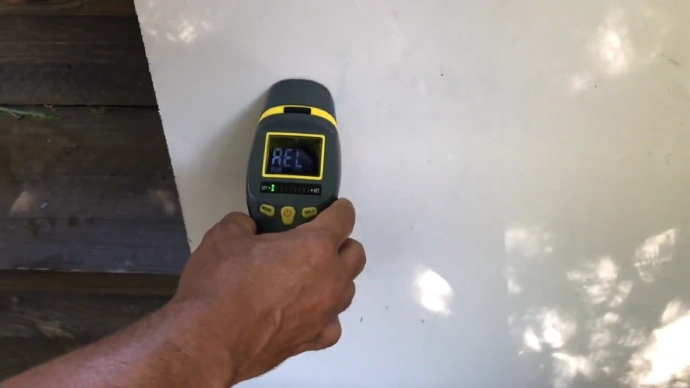Last Updated on March 13, 2023
When constructing a building, drywall needs to be perfectly balanced in terms of moisture levels. Getting this step right from the start will give your project an edge. Get it wrong, and you’ll compromise the finished product.
Not only does controlling moisture help to protect against mold, but it can also avoid costly repairs when things get too wet or too dry. But what exactly are the acceptable moisture levels for drywall?
Relative humidity certainly plays a role, but ultimately, the most important factor is the moisture content of the drywall itself. To be considered safe and secure, the moisture content needs to fall within a range of 5% to 12%.
Read on to learn more about methods with simple steps for measuring moisture levels in drywall and the core factors affecting the level of moisture in your drywall.
What are Acceptable Moisture Levels in Drywall: Factors that Can Affect

Factor 01: Humidity
The humidity level in a home is one of the most important factors that can impact moisture levels in drywall. The relative humidity should ideally be between 30-50% for optimal indoor air quality.
If the humidity is too high, it can cause moisture to accumulate in the drywall, leading to potential staining and deterioration of its surface. Also, high humidity levels can encourage mold growth, as mold spores thrive in damp environments.
If not addressed quickly, this can lead to further problems such as rot or structural damage.
To reduce moisture levels in drywall due to increased humidity, homeowners should use an effective humidifier or dehumidifier and ensure their ventilation systems are properly installed and functioning correctly.
Factor 02: Type of Humidifier Used
The type of humidifier used can also significantly impact moisture levels in drywall. While ultrasonic humidifiers may produce a large amount of vapor at once, allowing for a rapid increase and decrease in humidity as needed, evaporative humidifiers regulate humidity over time more slowly and evenly.
As such, when purchasing a humidifier for an area with drywall present, it is best to choose an evaporative model since it will provide a steadier level of humidity that won’t create significant fluctuations in moisture levels within the walls themselves.
Factor 03: Poor Level and Poor Quality of Ventilation
Poor ventilation is one of the primary reasons why moisture levels in drywall can increase significantly. If there is not enough fresh air flowing through an area with drywall present, then the humidity will remain high as moist air lingers inside without being able to escape outside.
To avoid this issue altogether, homeowners should ensure they correctly ventilate their living spaces with fans or open windows when possible.
Regularly testing the ventilation system to ensure it is operating at peak efficiency will ensure any lingering moisture is not trapped inside walls where it can cause long-term damage over time.
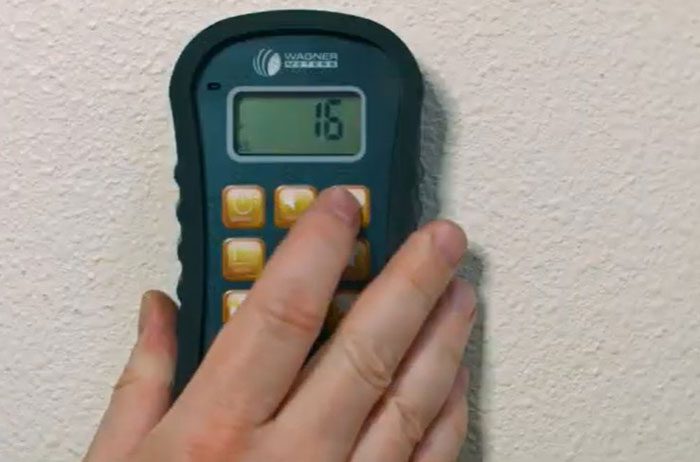
Factor 04: Condensation
Another factor that impacts moisture levels in drywall is condensation caused by temperature differences between inside and outside air temperatures (or within different areas within a space).
This happens when warm air touches things like metal pipes or windows. The water in the air turns into tiny drops on these things. It can even happen on walls if they are cold enough.
Homeowners should use insulation to stop condensation around pipes or windows. This will help because there won’t be a big difference in temperature between different areas or objects in the house.
Factor 05: Leaks or Water Damage
Any water damage in a home could also affect the drywall. This happens when too much liquid water gets into the property and is absorbed by things like paint or wallpaper on the walls. If this is not fixed quickly, it could lead to problems with the interior walls.
Homeowners need to regularly check their plumbing fixtures for any signs of wear and tear. This way, they can fix them before anything else gets damaged. To prevent leaks or water damage from ruining your drywall, look out for any visible mold stains and get them fixed as soon as possible.
Factor 06: Type of Insulation in Drywall
The type of insulation used in the drywall can play an essential role in affecting moisture levels. Generally speaking, materials such as fiberglass and foam are more effective at preventing moisture from seeping through than paper-faced insulation boards or rigid foam board insulation.
For example, fiberglass comprises multiple layers, which help trap air between them and reduce air movement through the wall cavity, which reduces condensation and helps keep moisture out of the drywall material.
Closed-cell foam rapidly absorbs water vapor. It prevents it from passing through its membrane structure which keeps condensation off the drywall surface and helps maintain proper indoor humidity levels.
As such, using these types of insulation materials can make a huge difference when attempting to reduce excessive moisture within a home’s walls.
Factor 07: Building Materials Used
The building materials used in constructing a home can also affect how much moisture accumulates within its walls over time. For example, brick walls are much better at keeping water out than wood-framed construction.
This is because they are more durable against weather conditions such as rain and snowfall. If there were a lot of moisture on the exterior walls, it would cause problems with humidity levels inside your home.
Using materials with vapor retarders during construction will help keep your home’s interior spaces from getting too much moisture. This happens when outside water vapor molecules try to pass through surfaces into your home’s air space.
If they are able to get inside, they might collect on cold surfaces like windowsills or shower stalls.
Factor 08: Location of Home
Finally, where you live can play an important role when evaluating factors that affect indoor humidity levels inside your home. Different climates require different approaches to controlling humidity because the weather patterns vary throughout the year.
These patterns change from month to month and year to year. For example, people who live in places with a lot of humidity might need to put dehumidifiers in their homes. These are machines that help keep the air inside from being too wet.
People who live in less humid places might not need them because there needs to be more moisture in the air for the machine to help with. Different places have different strategies for reducing indoor humidity levels.
This is important because if there is too much moisture in the air, it can damage your home’s drywall over time.
How to Measure Moisture Levels in Drywall?
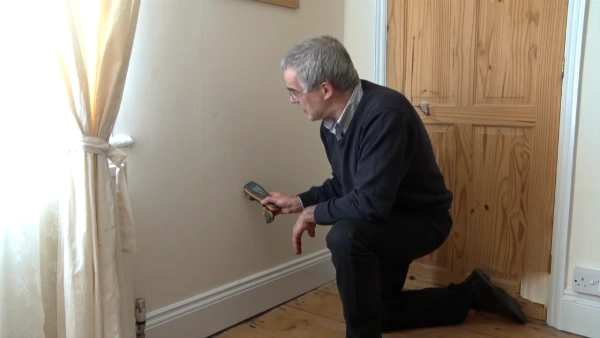
Measuring moisture levels in drywall is important in ensuring a healthy and safe home. Knowing the amount of moisture in drywall can help identify and address any potential problems. There are two primary methods to determine moisture levels in drywall: using a moisture meter or calculating humidity levels.
Method 01: Use a Moisture Meter

Step 1: Purchase a moisture meter. Look for a device that has features such as a digital display, adjustable measuring range, and user-friendly operation.
Step 2: Choose the appropriate probes for the drywall. Be sure to check the package instructions to ensure you use the correct probe for your task.
Step 3: Turn on the moisture meter and select the appropriate scale reading from its options. For drywall, choose between 6% and 20%.
Step 4: Place the probes into the drywall at different depths (up to 2-4 inches). Move around and do several readings so that you can compare results and get an accurate average.
Step 5: Read the output of your moisture meter. To get an accurate result, take several readings at each depth and then take an average before interpreting it.
Drywall should have between 0% and 10% moisture content depending on its application; anything over this level could indicate water damage or other issues that need further investigation.
Method 02: Calculate Humidity Levels
Step 1: Calculate relative humidity levels inside your home or building using a hygrometer to measure humidity levels in the air.
You should check multiple locations inside your home and outside to get an idea of normal humidity levels in your area at various times throughout the day and night.
Step 2: Record daily fluctuations in temperature and relative humidity near where your drywall is installed. At the same time, some degree of fluctuation is expected due to weather conditions outside.
Be aware of any unusual changes or drastic indoor spikes that could indicate structural issues such as water damage, inadequate insulation, or ventilation systems.
Step 3: Ensure proper upkeep of any appliances or features that generate heat or steam within close proximity (within 15 feet) of where your drywall is installed.
These include hot water heaters, furnaces, air conditioners, fireplaces, stoves or ovens, dishwashers, clothes washers, and dryers, etc.
Properly maintaining these appliances will help prevent excess moisture buildup in your walls, which could lead to mold growth or structural damage over time.
Step 4: Inspect all plumbing fixtures and pipes in the vicinity of your drywall often for any potential leaks. Suppose you notice any signs of discoloration on nearby walls, floors, ceilings, etc.
In that case, this could indicate excessive moisture accumulation due to leaking pipes, which can cause serious damage if left unattended.
How Accurate Are Drywall Moisture Readers?
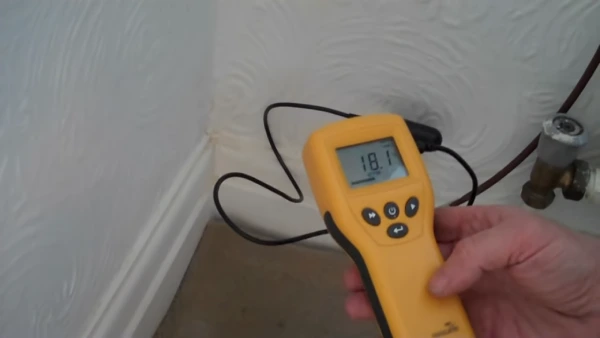
Drywall moisture readers are generally considered to be accurate when used correctly and within their operating range. Most professional-grade meters measure the relative humidity of the air trapped between the wall material and the drywall itself.
The accuracy of these readings is determined by factors such as the type of meter being used, the amount of time it takes for the meter to reach equilibrium with the environment, and any other conditions that may affect environmental readings.
Generally, a well-maintained and calibrated device can provide fairly accurate readings within its operating range.
Moisture In A Drywall House: How Much Is Too Much?
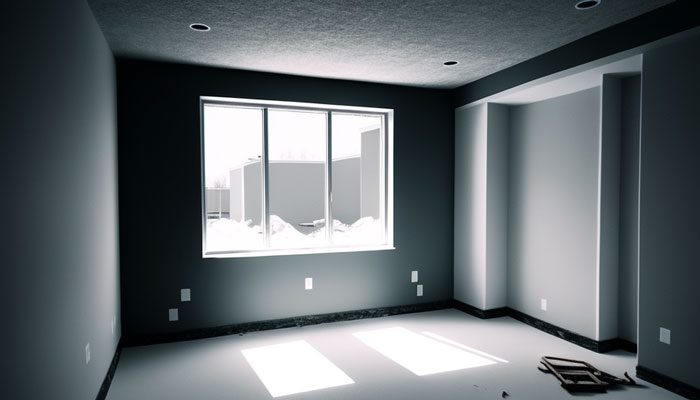
How much moisture is considered too much in a drywall house can vary depending on the environment and climate it is located in. A drywall house should have relative humidity levels between 30-50% and moisture content below twenty percent (20%) by weight.
Anything above this can cause excessive swelling or other problems with your drywall material or structure.
If you’re unable to maintain these levels using natural ventilation or air conditioning, then you may need to look into mechanical solutions such as dehumidifiers and air purifiers to reduce excess moisture in your home.
What Should A Moisture Meter Read On Drywall?
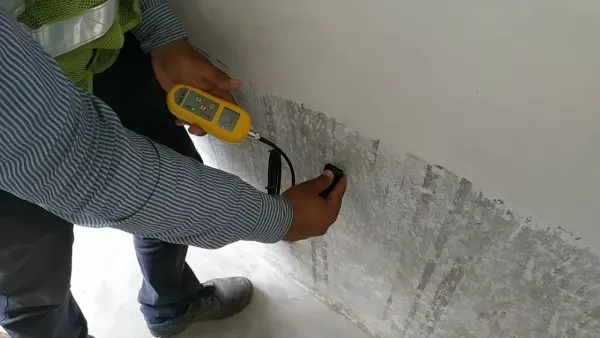
The ideal reading on a drywall moisture meter varies from one material to another. Non-gypsum-based materials such as cement boards should read around 8%, while gypsum boards should read around 12%.
However, these values depend heavily on the type of material used and the environment it is located in, so consider these variables when making decisions about what readings are acceptable.
Do Drywall Moisture Meters Detect Mold?
Drywall moisture meters do not detect mold directly because mold requires an organic source for growth, along with certain temperatures and humidity levels, to thrive successfully.
High levels of moisture indicated by a drywall meter could indicate potential areas where mold may exist due to an increase in these favorable conditions for growth if left unchecked.
This makes it important for homeowners who experience high readings from their meters to take action, such as fixing any leaks or removing standing water quickly to prevent mold from forming in their homes.
Final Thoughts
At its core, proper moisture management is an essential part of any building or construction project that involves drywall. To ensure proper levels of moisture and avoid costly repairs down the line, it’s important to make sure that your drywall’s moisture content remains between 5% and 12%.
If you keep this range in mind during your next project, you’ll be better prepared for success, no matter the challenges. Knowing the criteria for acceptable moisture levels in drywall can help you build confidence and ensure that your project lasts for a long time.
